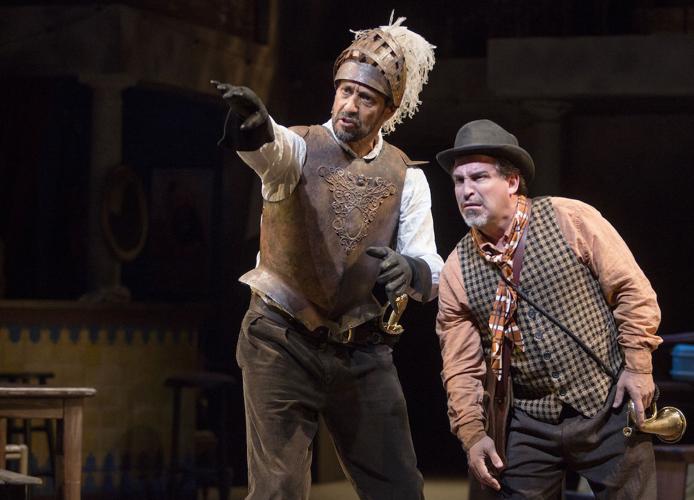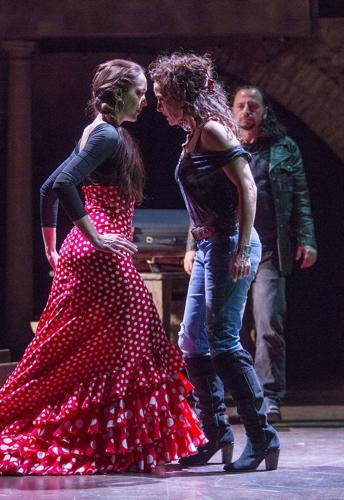David Bennett had an impossible dream.
The director wanted to take the potentially dated “Man of La Mancha,” dispense with the orchestra and put the musical instruments in the hands of the actors, add a flamenco guitarist and flamenco dancers, transport the story to Spain during Francisco Franco’s reign and mount a bare-bones production without all the fancy accouterments so often found in big musicals these days.
And the Arizona Theatre Company production that realizes that dream is brilliant.
Yes, brilliant.
“Man of La Mancha” hit the Broadway boards in 1965 and immediately won awards and fans. The set up is that Miguel de Cervantes, author of “Don Quixote,” has been thrown into prison during the Spanish Inquisition. His fellow prisoners immediately put him on trial, and his defense is to act out the story of Don Quixote, whose delusions are quite sane. Don Quixote travels looking for knightly things to do. His goals are simple, as laid out in the song “The Impossible Dream:” “...To fight the unbeatable foe/ To bear with unbearable sorrow/ To run where the brave dare not go. ....”
This profound “Man of La Mancha” speaks to today, when many of us have dared to dream and had those dreams shattered by the toxic environment in this country. This production underscores the despair and the hope in the story, and makes it clear that Don Quixote’s madness is very sane.
Bennett does not deviate from the script, but the elements he adds elevate the story and reveal new layers in it.
Flamenco dance was part of the original production, but Bennett uses it more fully here and it serves as a thundering punctuation to several scenes. The dancers, Jose Luis ”El Nino” Uz and Amelia Moore, are powerful additions. For instance: Aldonza, who makes her living as a barmaid and a prostitute, is called Dulcinea by Don Quixote. He believes her to be a beautiful and virtuous lady. Moore is Aldonza’s inner Dulcinea, tall and elegant and brave. She steps in when Aldonza falters. There’s a moment late in the play, after Aldonza has begun to see herself the way Don Quixote does, that she is attacked by a number of men. Moore glides in when Aldonza can no longer stand. She performs a fierce battle dance, but she, too, is defeated. The two women walk off hand in hand, shattered. Aldonza no longer sees the Dulcinea in herself. It is heartbreaking.
Michelle Dawson took on the role of Aldonza last week when the actress originally cast fell ill. You’d never know it; in addition to a gorgeous voice, Dawson possessed the character.
The flamenco guitarist, Joaquin Gallegos, is so good he is dizzying. And Bennett’s concept of making the actors the musicians, and forgoing the intermission, adds to a sense of reality in this fantasy world.
But great concepts won’t go far unless you have the actors to carry that off. And Bennett has that, especially in Philip Hernandez as Cervantes/Quixote. He was deeply rooted in the characters. In his hands, we believed in Quixote’s dreams and desperately wanted him to achieve them. When he sings “The Impossible Dream,” forget everyone else who ever sang it, from Frank Sinatra to Elvis Presley to the Mormon Tabernacle Choir. Hernandez’s version is raw and comes from deep in his soul. His is noble and stirring, and better than all the rest.
Carlos Lopez was captivating and provided much of the lighter moments as Quixote’s man servant, Sancho.
This cast is packed with talent, from John Patrick Lowrie as the man dubbed the Governor of the prison to Marissa Salazar, who plays one of the prisoners.
We are taken even deeper into Quixote's universe thanks to Kathryn Van Meter's spot-on choreography and William Bloodgood's scenic design of a bar basement made into a makeshift prison.
Bennett has shaped a production that feels wildly relevant today, when so much turmoil is suffocating our country. He made us believe that we must reach for that unreachable star; that hope must not be lost.
The director’s vision has resulted in a dream production. This is among the best ATC has done.





